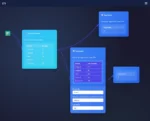
by tyler garrett | Mar 28, 2023 | Business
Social media has become an integral part of people’s lives. It has not only transformed the way we interact with each other but has also revolutionized the way businesses operate. Social media platforms have enabled businesses to communicate with their customers directly, gather feedback, and market their products and services in real-time. However, social media also presents unique challenges for businesses, especially when it comes to data quality and analysis.
Social media data is a goldmine of information for businesses. It provides insights into customer behavior, preferences, and sentiments. Social media data can help businesses identify trends, improve their products and services, and make better decisions. For example, social media data can be used to identify the most popular products or services, analyze customer feedback using sentiment analysis, and track the effectiveness of marketing campaigns.
However, social media data is often unstructured, meaning it is not organized in a predefined manner. This can make it challenging for businesses to analyze social media data effectively. Additionally, social media data can be influenced by fake news, spam, and bots, which can skew the data and make it difficult to distinguish between real and fake information.
To overcome these challenges, businesses need to adopt a robust business intelligence (BI) strategy that incorporates social media data and we have experience helping people with the data engineering services required to gain these insights, plus have experience visualizing the data in our Tableau Consulting Services.
A good BI strategy should include data quality checks to ensure that social media data is accurate and reliable. It should also include data cleansing, ETL to clean and transform messy data or ELT, and transformation processes to convert unstructured data into a structured format that can be analyzed using BI tools.
Social media analytics tools are another essential component of a good BI strategy. These tools use advanced algorithms and machine learning to analyze social media data and provide valuable insights. Social media analytics tools can help businesses identify key influencers, track sentiment trends, and monitor brand reputation in real-time.
Another critical aspect of incorporating social media data into a BI strategy is to ensure data privacy and security. Social media platforms collect vast amounts of data about their users, including personal information such as names, addresses, and contact details. Businesses must ensure that they comply with data privacy laws and regulations when collecting and using social media data.
In conclusion, social media has a significant impact on business intelligence. Social media data provides valuable insights into customer behavior and preferences, but it also presents unique challenges in terms of data quality and analysis. To overcome these challenges, businesses must adopt a robust BI strategy that incorporates social media data, including data quality checks, data cleansing and transformation processes, and social media analytics tools. Additionally, businesses must ensure data privacy and security to comply with laws and regulations. By doing so, businesses can gain a competitive edge and drive growth.

by tyler garrett | Jan 20, 2023 | Automation, Databasehelp
Designing, improving, and automating processes like database provision, schema migration, and capacity planning can be a challenging task, but with the right approach, it can be made much simpler. In this article, we will explore some best practices and tools that can help you design, improve, and automate these processes.
- Designing processes
The first step in designing processes is to understand the requirements of the system. This includes understanding the data that will be stored, the number of users, and the expected load on the system. Once you have a good understanding of the requirements, you can start designing the processes.
It’s important to keep in mind that the processes should be designed to be as simple and efficient as possible. This means that they should be easy to understand and maintain, and they should be designed to minimize the number of steps required to complete a task.
- Improving processes
Once the processes have been designed, it’s important to continuously monitor and improve them. This can be done by analyzing the performance of the system and looking for areas where improvements can be made. Common areas for improvement include reducing the number of steps required to complete a task, optimizing the performance of the system, and reducing the amount of manual work required.
- Automating processes
Automating processes can significantly improve the efficiency and reliability of your system. This can be done by using tools like configuration management tools, which can be used to automate the provisioning and configuration of your system. Additionally, you can use tools like database migration tools, which can be used to automate the process of migrating data between different database systems.
- Capacity Planning
Capacity planning is an important step in ensuring that your system is able to handle the expected load. This involves determining the amount of resources required to support the system, and then scaling the system accordingly. This can be done by monitoring the performance of the system, and then making adjustments as needed.
In conclusion, designing, improving, and automating processes like database provision, schema migration, and capacity planning can be a challenging task, but with the right approach, it can be made much simpler. By understanding the requirements of the system, designing simple and efficient processes, continuously monitoring and improving the processes, and automating the processes, you can ensure that your system is able to handle the expected load and provide a high level of performance.

by tyler garrett | Jan 20, 2023 | Solutions
Here’s a polished rewrite of the piece with a more modern, consulting-savvy tone, built for blog or LinkedIn visibility—and a few links to dev3lop.com added in naturally to align with your offerings:
The Finance Industry’s Over-Reliance on Data: The Risks and Drawbacks
In today’s finance world, data is king. From algorithmic trading and credit risk modeling to customer segmentation and fraud detection, data-driven strategies have become the norm. But as the industry races to automate, quantify, and optimize, it risks leaning too far into the data pool—and drowning in unintended consequences.
At DEV3LOP, we help businesses strike a healthy balance between data automation and human insight. And in the finance space, that balance is more crucial than ever.
The Hidden Dangers of Biased Data
The finance industry’s love for data often masks a serious issue: bias. Much of the data being used is self-reported, outdated, or pulled from limited sources, creating blind spots in analysis. As a result, decision-making skews toward reinforcing past patterns rather than adapting to changing market realities or underserved demographics.
Without proper data audits or a strategy to ensure diverse inputs, financial institutions risk building tools and processes that serve the few—while alienating the many. This is why we recommend regular data quality assessments and architecture reviews as part of any analytics strategy.
Over-Automation Undermines Accountability
From robo-advisors to loan approval algorithms, automation is everywhere. But when you replace too much human oversight with machines, things go wrong—quietly and at scale.
Automated systems can deny loans, flag transactions, or misjudge creditworthiness based on flawed logic or outdated models. Worse, they often lack transparency. Customers and regulators are left in the dark, unable to understand why a decision was made. At DEV3, we advocate for hybrid systems—automated where it helps, but always layered with explain-ability and human review.
Innovation Takes a Backseat
Chasing yesterday’s KPIs can stall tomorrow’s progress. A hyper-focus on metrics and historical trends can trap teams in a feedback loop of incremental optimization instead of bold innovation.
Many financial organizations struggle to evolve beyond what’s measurable, ignoring qualitative insights, customer empathy, and market intuition. That’s where data consultants can play a key role—unlocking creative solutions that aren’t confined to dashboards and spreadsheets.
The Cost of Keeping Up
Data isn’t cheap. Between storage infrastructure, security protocols, machine learning tools, and full-time data science teams, even mid-size firms can find themselves buried in technical debt.
Smaller players in the financial sector face an uphill battle just to participate. And when data becomes a barrier instead of an advantage, it’s time to reassess your stack. At DEV3LOP, we’ve helped firms trim unnecessary tools, simplify pipelines, and find scalable alternatives to bloated platforms.
Privacy and Trust Are on the Line
As the industry continues to harvest and analyze personal financial behavior, trust hangs in the balance. Data breaches, misuse of personal information, and the creep factor of overly personalized insights can quickly damage brand reputation.
In a post-GDPR, privacy-first world, data ethics are no longer optional—they’re strategic. Transparency in how data is collected, processed, and applied is essential, and your systems need to be designed with accountability at their core.
The Bottom Line
Data is powerful, but it’s not a silver bullet. Over-reliance on it—especially without governance, context, or critical thinking—can introduce risk, erode trust, and stall innovation. The financial services industry needs to rethink the role of data: not as the driver, but as the co-pilot.
Need help building a smarter, more balanced approach to data strategy in finance? Let’s talk.

by tyler garrett | Jan 13, 2023 | Business
A data strategy is a plan that outlines how an organization will collect, store, manage, and use data to support its goals and objectives. It defines the policies, procedures, and technologies that will be used to turn data into actionable insights and guides decision making at all levels of the organization.
What is the difference between data strategy and data governance?
A solid data strategy is becoming increasingly important in today’s digital age, as more and more companies are sitting on vast amounts of data that can be used to inform business decisions and drive growth. However, without a clear plan in place for how to collect, manage, and make sense of this data, it can become overwhelming and difficult to extract value from it.
There are many different components of a data strategy, including data governance, data warehousing, analytics, and data visualization. By putting a data strategy in place, companies can ensure that their data is accurate, secure, and properly used, and that the insights gleaned from the data are actionable and relevant to the business.
In order to turn that data into valuable insights, companies need to have a solid data strategy in place. There are many different data strategies that companies can use, and in this article, we will explore 29 examples of data strategies that have been used by businesses.
- Data segmentation: dividing customers into groups based on demographics, behavior, or other characteristics.
- Personalization: Personalization is the process of tailoring products, services, or marketing messages to the individual preferences and needs of customers. By using a data strategy to collect and analyze data on customer behavior and demographics, companies can create personalized experiences that increase engagement and drive sales.
- Predictive maintenance: In manufacturing and other industries, predictive maintenance is the process of using data analysis to identify when equipment or machinery needs maintenance or replacement to minimize downtime. By using a data strategy to collect and analyze data from sensors and other sources, companies can schedule maintenance at the optimal time, reducing downtime and increasing productivity.
- A/B testing: running experiments to compare two versions of a product or marketing campaign.
- Customer lifetime value (CLV) analysis: estimating the total value of a customer to a business over their lifetime.
- Market basket analysis: identifying items that are frequently purchased together in order to inform product recommendations or pricing strategies.
- Predictive modeling: using data on past behavior to make predictions about future behavior.
- Sentiment analysis: determining the emotional tone of customer feedback in order to inform product development or marketing strategies.
- Recommendation systems: suggesting products or content to users based on their past behavior.
- Natural Language Processing (NLP): analyzing and making sense of unstructured data like customer feedback, social media posts, and news articles.
- Customer profiling: building detailed profiles of customers based on their demographics, behavior, and other data.
- Fraud detection: Fraud is a major concern for businesses of all sizes. By using data and advanced analytics techniques, companies can identify patterns of fraudulent behavior, prevent fraud, and minimize financial losses.
- Data Governance : Defining roles, responsibilities, and policies for data management, access, and security.
- KPI (key performance indicator) tracking: monitoring specific metrics in order to gauge the performance of a business or specific campaign.
- Data Warehousing: Storing large amount of data in a central repository to support business intelligence and analytics initiatives.
- Big Data: Processing large, complex data sets to uncover insights that can inform business decisions.
- Data Visualization: Creating charts, graphs, and other visualizations to help users understand and make sense of data.
- Root cause analysis: Identifying the underlying reasons for a problem or issue in order to inform decision making.
- Data Cleansing: Removing or correcting data errors, duplicates, and inconsistencies.
- Scorecarding: Using data to evaluate the performance of a business, product, or campaign.
- Backtesting: Applying historical data to evaluate the performance of a trading strategy or financial model.
- Data Monitoring: Continuously tracking data to identify changes or trends that may be important to the business.
- Geo-location analysis: Analyzing geographic data to identify patterns, trends or areas that are of interest to the business.
- Text mining: Using natural language processing and machine learning to extract insights from large volumes of text data.
- Social network analysis: Identifying key individuals, groups, or clusters of people within a network of relationships.
- Customer Segmentation: Dividing customers into distinct groups based on demographics, behaviors, or other characteristics.
- Data Dictionaries: Creating metadata about the data that is stored, like data elements and relationships, for better data governance and management.
- Master Data Management: Managing and maintaining a central and consistent set of core data that is used across the organization.
- Experiment Design: Planning and designing controlled experiments to test hypotheses and measure the impact of interventions.
In conclusion, a data strategy is an essential part of any modern business. There are many different data strategies that companies can use to make sense of the data they have collected and use it to drive growth. From data segmentation and A/B testing to customer lifetime value analysis and predictive modeling, the strategies outlined in this article offer a broad overview of the many ways that companies can use data to inform their decisions and gain a competitive edge. It is important to consider which data strategies align with the goals and resources of the company and to continuously review and improve the data strategy over time in response to new trends and new data. Having a solid data strategy can help companies maximize the value of their data and achieve success in today’s digital marketplace.

by tyler garrett | Dec 31, 2022 | Business
Welcome to 20 Tips Executives Need to Understand About Data Warehousing! In this article, we will explore the key considerations that executives should understand when it comes to data warehousing. Data warehousing is a powerful tool for business intelligence and decision-making, and a well-designed and maintained data warehouse can provide valuable insights into an organization’s operations, performance, and trends. However, building and maintaining a data warehouse requires careful planning and attention to detail. In this article, we will cover the business requirements for the data warehouse, the data sources and data model, the ETL processes, query and analysis tools, data governance and compliance, performance and scalability, and maintenance and support. By understanding these tips, executives can ensure that their data warehouse services are successful and supports the needs of the organization.
- Understand the business requirements for your data warehouse. Identify the types of questions that the data warehouse will be used to answer, and the types of data that will be needed to answer those questions.
- Design the data warehouse schema with the future in mind. The schema should be flexible enough to support your current and future business needs, while also being efficient and easy to use.
- Use ETL tools and processes to efficiently extract, transform, and load data into the data warehouse.
- Choose the right hardware and software to support your data warehouse. This may include choosing a database management system, a data warehouse appliance, or a cloud-based solution.
- Implement security measures to protect the data in your data warehouse. This may include encryption, access controls, and data masking.
- Consider data governance and compliance requirements, such as those related to data privacy and data retention.
- Use a business intelligence tool or SQL to query and analyze the data in the data warehouse. This will allow you to gain insights and make informed decisions based on the data.
- Regularly update and maintain the data warehouse to ensure the data is accurate and up-to-date.
- Monitor the performance of the data warehouse and optimize as needed.
- Use data modeling techniques to design a clear and concise schema.
- Implement data cleansing and data profiling to improve the quality of your data.
- Use data lineage to track the origins and transformations of data within your data warehouse.
- Document your data using data dictionaries and metadata management techniques.
- Ensure the accuracy and reliability of your data through data governance and stewardship practices.
- Use data integration and data transformation techniques to combine and format data from various sources.
- Communicate insights from your data warehouse through effective data visualization.
- Use data mining and machine learning techniques to uncover patterns and trends within your data.
- Store and process large amounts of data using data lake and big data technologies.
- Adhere to regulatory and legal requirements through the use of data governance and compliance frameworks.
- Create a scalable and maintainable data warehouse through the use of data architecture and design patterns.
Why do executives need to know about data warehousing?
Executives need to know about data warehousing because it is a key tool for business intelligence and decision-making. A well-designed and maintained data warehouse can provide executives with valuable insights into the organization’s operations, performance, and trends. By querying and analyzing the data in the data warehouse, executives can make informed decisions that can improve efficiency, reduce costs, and drive revenue.
Additionally, data warehousing is often a significant investment for organizations, both in terms of resources and budget. As such, executives need to be aware of the business requirements for the data warehouse, the costs and benefits of different hardware and software options, and the ongoing maintenance and support required to ensure the data warehouse is successful.
Finally, data governance and compliance are increasingly important considerations for organizations. Executives need to be aware of the regulations and legal requirements related to data privacy, data retention, and data security, and ensure that the data warehouse meets these requirements.
Important phrases related to data warehousing that will help executives understand more!
- Business requirements: It is important for executives to understand the business requirements for the data warehouse and how it will be used to support decision-making and business intelligence. This will help guide the design and development of the data warehouse, and ensure that it meets the needs of the organization.
- Data sources: Executives should be aware of the various data sources that will be used to populate the data warehouse, including structured and unstructured data, and how these sources will be integrated and transformed for use in the data warehouse.
- Data model: The data model is the blueprint for the data warehouse, defining the tables and relationships between those tables. It is important for executives to understand the data model and how it will support the business requirements of the data warehouse.
- ETL processes: The extract, transform, and load (ETL) processes are responsible for moving data from various sources into the data warehouse. It is important for executives to understand the ETL processes and how they will be implemented and maintained.
- Query and analysis tools: Executives should be aware of the tools and technologies that will be used to query and analyze the data in the data warehouse, such as SQL or a business intelligence tool.
- Data governance and compliance: Data governance and compliance are critical considerations for any data warehouse. Executives should understand the regulations and legal requirements related to data privacy, data retention, and data security, and ensure that the data warehouse meets these requirements.
- Performance and scalability: The performance and scalability of the data warehouse are important considerations, especially as the volume and complexity of the data increases. Executives should understand the measures that will be taken to ensure the data warehouse can meet the performance and scalability needs of the organization.
- Maintenance and support: The data warehouse will require ongoing maintenance and support to ensure it is accurate and up-to-date. Executives should understand the resources and budget required to support the data warehouse, and ensure that these are in place.





























